Alaska Economic Trends
Alaska Economic Trends is a monthly magazine that covers a range of economic topics.
Sign up for a free electronic subscription. 
Sign up for a paid print subscription.
Alaska Economic Trends are searchable from 1961 to the present using the Trends search page. The search can include any combination of the following: Key Words, Date Range, Author, Category
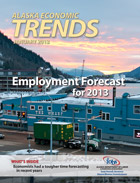
Alaska added jobs at a pace of 1.6 percent in 2012, continuing a three-year trend of employment growth that followed the end of the national recession. The state is expected to continue gaining jobs in 2013 but at a slightly more modest pace - 1.2 percent, or 4,200 new jobs statewide.
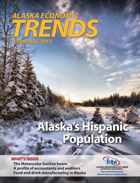
Alaska is home to people from many backgrounds, and its increasing diversity has become more apparent in recent decades as its economy and population have grown and changed rapidly. Though people of Hispanic or Latino origin make up a smaller share of the state population than the nation as a whole, they are a growing part of this ever-changing state and its economy.
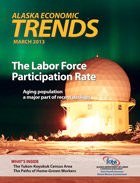
The labor force participation rate - essentially the percentage of the population 16 or older that's either working or actively seeking work - has declined in both Alaska and the U.S. as a whole over the last decade. But labor force participation rates rise and fall for different reasons, and moves in either direction do not in themselves signal a strengthening or weakening economy.
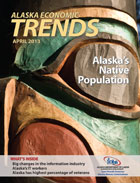
Alaska is home to one of the largest indigenous populations in the nation. With more than 120,000 people, Alaska Natives represented 17 percent of the state in 2010 - a larger proportion than any other state. The Alaska Native population is made up of many distinct cultures and has lands in each region of Alaska. After large population declines that followed early contact with Europeans in the 18th and 19th centuries, the Native population has grown substantially over the past 100 years, and that growth is projected to continue.
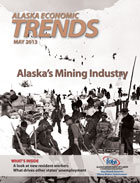
Alaska's mining industry has been a standout over the last decade for its job and wage growth, and the production value of its minerals climbed from less than $1 billion in 2001 to $3.5 billion in 2011. The gains have come from new mines as well as expanded operations at existing mines, and increasing exploration and development spending suggest more growth in the future.

Oil's contribution to Alaska's economic history has no equal. Historians write that the discovery of oil in Cook Inlet helped secure Alaska's quest for statehood, and the subsequent massive discovery of oil in Prudhoe Bay remains the largest in North America. In the decades since, oil has played the leading role in all the state's major economic and population changes.

The overall cost of living in Anchorage rose a modest 2.2 percent between 2011 and 2012. This inflation rate was a full percentage point below the prior year's rate and the third lowest in a decade. The 10-year average was 2.7 percent, putting 2012's rate in the typical range.

Job hoppers - workers who repeatedly move from employer to employer, never staying with a single one for an extended period - raise key questions about work, careers, and the intersection between what employers and employees want. There are no regularly published national numbers or even a uniform definition of the term, but a preliminary analysis of Alaska's data shows that: 1) job hopping is more common among younger age groups; and 2) the state had a smaller percentage of job hoppers in 2011 than in 2001.

Though almost all of Anchorage's population still lives within a fairly small area, its growth since 1980 has spread out from the more densely populated areas around downtown and midtown.
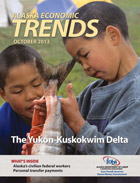
The picturesque coastline of this southwestern Alaska region is marked by the mighty Yukon and Kuskokwim rivers spilling out into the Bering Sea. The alluvial deposits left by the rivers wanderings formed the landscape now known as the Yukon-Kuskokwim Delta.

Alaska is among the world's leaders for seafood harvesting, with landings worth more than $1.7 billion in 2012 and more than half of all fish caught commercially in the United States. Six of the top 10 national ports for value and four of the top 10 for poundage are in Alaska, and for the 16th straight year, Dutch Harbor-Unalaska led the nation for pounds landed.
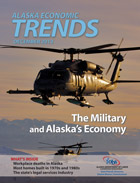
One of the federal government's first acts after purchasing Alaska was to send the U.S. Army to occupy and administer its new territory. However, it wasn't until World War II that the military solidified its role as one of Alaska's economic mainstays. The military's presence in the 1940s was so major and transformational that the state was commonly referred to as 'Military Alaska.' More than 100,000 troops poured into the state along with billions of dollars for infrastructure.
